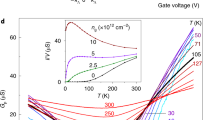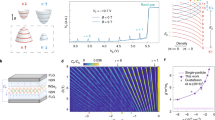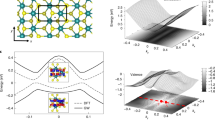Abstract
The interplay between topology and correlations can generate a variety of quantum phases, many of which remain to be explored. Recent advances have identified monolayer WTe2 as a promising material for doing so in a highly tunable fashion. The ground state of this two-dimensional crystal can be electrostatically tuned from a quantum spin Hall insulator to a superconductor. However, much remains unknown about the gap-opening mechanism of the insulating state. Here we report evidence that the quantum spin Hall insulator is also an excitonic insulator, arising from the spontaneous formation of electron–hole bound states, namely excitons. We reveal the presence of an intrinsic insulating state at the charge neutrality point in clean samples and confirm the correlated nature of this charge-neutral insulator by tunnelling spectroscopy. We provide evidence against alternative scenarios of a band insulator or a localized insulator and support the existence of an excitonic insulator phase in the clean limit. These observations lay the foundation for understanding a new class of correlated insulators with nontrivial topology and identify monolayer WTe2 as a promising candidate for exploring quantum phases of ground-state excitons.
This is a preview of subscription content, access via your institution
Access options
Access Nature and 54 other Nature Portfolio journals
Get Nature+, our best-value online-access subscription
$29.99 / 30 days
cancel any time
Subscribe to this journal
Receive 12 print issues and online access
$209.00 per year
only $17.42 per issue
Buy this article
- Purchase on Springer Link
- Instant access to full article PDF
Prices may be subject to local taxes which are calculated during checkout




Similar content being viewed by others
Data availability
The data that support the plots within this paper are available at https://doi.org/10.7910/DVN/FFGQOX. Other data that support the findings of this study are available from the corresponding authors upon reasonable request.
References
Ren, Y., Qiao, Z. & Niu, Q. Topological phases in two-dimensional materials: a review. Rep. Prog. Phys. 79, 066501 (2016).
Jérome, D., Rice, T. M. & Kohn, W. Excitonic insulator. Phys. Rev. 158, 462–475 (1967).
Kohn, W. Excitonic phases. Phys. Rev. Lett. 19, 439–442 (1967).
Blatt, J. M., Böer, K. W. & Brandt, W. Bose-Einstein condensation of excitons. Phys. Rev. 126, 1691–1692 (1962).
Kotov, V. N., Uchoa, B., Pereira, V. M., Guinea, F. & Castro Neto, A. H. Electron-electron interactions in graphene: current status and perspectives. Rev. Mod. Phys. 84, 1067–1125 (2012).
Elias, D. C. et al. Dirac cones reshaped by interaction effects in suspended graphene. Nat. Phys. 7, 701–704 (2011).
Varsano, D., Palummo, M., Molinari, E. & Rontani, M. A monolayer transition-metal dichalcogenide as a topological excitonic insulator. Nat. Nanotechnol. 15, 367–372 (2020).
Zheng, B. & Fu, L. Excitonic density wave and spin-valley superfluid in bilayer transition metal dichalcogenide. Nat. Commun. 12, 642 (2021).
Barkeshli, M., Nayak, C., Papić, Z., Young, A. & Zaletel, M. Topological exciton Fermi surfaces in two-component fractional quantized Hall insulators. Phys. Rev. Lett. 121, 026603 (2018).
Pikulin, D. I. & Hyart, T. Interplay of exciton condensation and the quantum spin Hall effect in InAs/GaSb bilayers. Phys. Rev. Lett. 112, 176403 (2014).
Blason, A. & Fabrizio, M. Exciton topology and condensation in a model quantum spin Hall insulator. Phys. Rev. B 102, 035146 (2020).
Hu, Y., Venderbos, J. W. F. & Kane, C. L. Fractional excitonic insulator. Phys. Rev. Lett. 121, 126601 (2018).
Chowdhury, D., Sodemann, I. & Senthil, T. Mixed-valence insulators with neutral Fermi surfaces. Nat. Commun. 9, 1766 (2018).
Cercellier, H. et al. Evidence for an excitonic insulator phase in 1T–TiSe2. Phys. Rev. Lett. 99, 146403 (2007).
Li, Z. et al. Possible excitonic insulating phase in quantum-confined Sb nanoflakes. Nano Lett. 19, 4960–4964 (2019).
Kogar, A. et al. Signatures of exciton condensation in a transition metal dichalcogenide. Science 358, 1314–1317 (2017).
Du, L. et al. Evidence for a topological excitonic insulator in InAs/GaSb bilayers. Nat. Commun. 8, 1971 (2017).
Wakisaka, Y. et al. Excitonic insulator state in Ta2NiSe5 probed by photoemission spectroscopy. Phys. Rev. Lett. 103, 026402 (2009).
Lu, Y. F. et al. Zero-gap semiconductor to excitonic insulator transition in Ta2NiSe5. Nat. Commun. 8, 14408 (2017).
Fukutani, K. et al. Electrical tuning of the excitonic insulator ground state of Ta2NiSe5. Phys. Rev. Lett. 123, 206401 (2019).
Yu, W. et al. Anomalously large resistance at the charge neutrality point in a zero-gap InAs/GaSb bilayer. New J. Phys. 20, 053062 (2018).
Eisenstein, J. P. Exciton condensation in bilayer quantum Hall systems. Annu. Rev. Condens. Matter Phys. 5, 159–181 (2014).
Liu, X., Watanabe, K., Taniguchi, T., Halperin, B. I. & Kim, P. Quantum Hall drag of exciton condensate in graphene. Nat. Phys. 13, 746–750 (2017).
Li, J. I. A., Taniguchi, T., Watanabe, K., Hone, J. & Dean, C. R. Excitonic superfluid phase in double bilayer graphene. Nat. Phys. 13, 751–755 (2017).
Qian, X., Liu, J., Fu, L. & Li, J. Quantum spin Hall effect in two-dimensional transition metal dichalcogenides. Science 346, 1344–1347 (2014).
Fei, Z. et al. Edge conduction in monolayer WTe2. Nat. Phys. 13, 677–682 (2017).
Tang, S. et al. Quantum spin Hall state in monolayer 1T′-WTe2. Nat. Phys. 13, 683–687 (2017).
Wu, S. et al. Observation of the quantum spin Hall effect up to 100 kelvin in a monolayer crystal. Science 359, 76–79 (2018).
Fatemi, V. et al. Electrically tunable low-density superconductivity in a monolayer topological insulator. Science 362, 926–929 (2018).
Sajadi, E. et al. Gate-induced superconductivity in a monolayer topological insulator. Science 362, 922–925 (2018).
Muechler, L., Alexandradinata, A., Neupert, T. & Car, R. Topological nonsymmorphic metals from band inversion. Phys. Rev. X 6, 041069 (2016).
Zheng, F. et al. On the quantum spin Hall gap of monolayer 1T′-WTe2. Adv. Mater. 28, 4845–4851 (2016).
Xu, S.-Y. et al. Electrically switchable Berry curvature dipole in the monolayer topological insulator WTe2. Nat. Phys. 14, 900–906 (2018).
Song, Y.-H. et al. Observation of Coulomb gap in the quantum spin Hall candidate single-layer 1T′-WTe2. Nat. Commun. 9, 4071 (2018).
Rhodes, D., Chae, S. H., Ribeiro-Palau, R. & Hone, J. Disorder in van der Waals heterostructures of 2D materials. Nat. Mater. 18, 541–549 (2019).
Ali, M. N. et al. Correlation of crystal quality and extreme magnetoresistance of WTe2. Europhys. Lett. 110, 67002 (2015).
Efros, A. L. & Shklovskii, B. I. Coulomb gap and low temperature conductivity of disordered systems. J. Phys. C 8, L49–L51 (1975).
Kivelson, S., Lee, D.-H. & Zhang, S.-C. Global phase diagram in the quantum Hall effect. Phys. Rev. B 46, 2223–2238 (1992).
Hilke, M. et al. Experimental evidence for a two-dimensional quantized Hall insulator. Nature 395, 675–677 (1998).
Ebisawa, H. & Fukuyama, H. Hall effect in excitonic insulator. Prog. Theor. Phys. 42, 512–522 (1969).
Campbell, D. J. et al. Intrinsic insulating ground state in transition metal dichalcogenide TiSe2. Phys. Rev. Mater. 3, 053402 (2019).
Li, G. et al. Semimetal-to-semimetal charge density wave transition in 1T−TiSe2. Phys. Rev. Lett. 99, 027404 (2007).
Ponomarenko, L. A. et al. Cloning of Dirac fermions in graphene superlattices. Nature 497, 594–597 (2013).
Cao, Y. et al. Tunable correlated states and spin-polarized phases in twisted bilayer–bilayer graphene. Nature 583, 215–220 (2020).
Chandni, U., Watanabe, K., Taniguchi, T. & Eisenstein, J. P. Signatures of phonon and defect-assisted tunneling in planar metal–hexagonal boron nitride–graphene junctions. Nano Lett. 16, 7982–7987 (2016).
Raja, A. et al. Coulomb engineering of the bandgap and excitons in two-dimensional materials. Nat. Commun. 8, 15251 (2017).
Zhao, C. et al. Strain tunable semimetal–topological-insulator transition in monolayer 1T′–WTe2. Phys. Rev. Lett. 125, 046801 (2020).
Acknowledgements
We acknowledge helpful discussions with N. P. Ong and P. A. Lee. Work in the Wu lab was primarily supported by the National Science Foundation (NSF) through a CAREER award to S.W. (DMR-1942942). Device fabrication was supported by NSF-MRSEC through the Princeton Center for Complex Materials (DMR-1420541 and DMR-2011750). S.W. and L.M.S. acknowledge the support from the Eric and Wendy Schmidt Transformative Technology Fund at Princeton. Part of the measurements was performed at the National High Magnetic Field Laboratory, which is supported by NSF cooperative agreement no. DMR-1644779 and the State of Florida. Work in the Yazdani lab was primarily supported by the Gordon and Betty Moore Foundation EPiQS initiative grants GBMF4530 and GBMF9469 and by the Department of Energy (DOE) BES grant DE-FG02-07ER46419. Other support for the experimental work by A.Y. was provided by NSF (DMR-1904442), ExxonMobil through the Andlinger Center for Energy and the Environment at Princeton, and the Princeton Catalysis Initiative. B.A.B. is supported by DOE grant no. DE-SC0016239, the Schmidt Fund for Innovative Research, Simons Investigator grant no. 404513 and the Packard Foundation for the numerical work. The analytical part was supported by NSF EAGER grant no. DMR-1643312, United States–Israel BSF grant no. 2018226, ONR grant no. N00014-20-1-2303 and the Princeton Global Network Funds. Additional support to B.A.B. was provided by the Gordon and Betty Moore Foundation through grant no. GBMF8685 towards the Princeton theory program. B.J. acknowledges funding through a postdoctoral fellowship of the Alexander-von-Humboldt Foundation. K.W. and T.T. acknowledge support from MEXT Element Strategy Initiative (Japan) grant no. JPMXP0112101001, JSPS KAKENHI grant no. JP20H00354 and the JST CREST (JPMJCR15F3). F.A.C. and R.J.C. acknowledge support from the ARO MURI on Topological Insulators (grant no. W911NF1210461). S.L, S.K. and L.M.S. acknowledge support from the Gordon and Betty Moore Foundation through grant no. GBMF9064 awarded to L.M.S.
Author information
Authors and Affiliations
Contributions
S.W. supervised transport and vdW tunnelling studies. A.Y. supervised STM studies. P.W. and G.Y. fabricated transport devices. Y.J. fabricated the vdW tunnelling devices, assisted by P.W., G.Y., M.O., N.F. and B.J. Y.J., P.W., and S.W. performed transport and vdW tunnelling measurements and analysed data. C.-L.C., Y.J., P.W. and X.L. fabricated the STM device. C.-L.C., G.F., X.L. and B.J. performed STM measurements and analysed data. Z.S., F.X., Y.X. and B.A.B. provided theoretical support. S.L., S.K., L.M.S., F.A.C. and R.J.C. grew and characterized bulk WTe2 crystals. K.W. and T.T. provided hBN crystals. All authors discussed the result and contributed to the writing of the paper.
Corresponding authors
Ethics declarations
Competing interests
The authors declare no competing interests.
Additional information
Peer review information Nature Physics thanks Vitor Pereira, Jinfeng Jia and the other, anonymous, reviewer(s) for their contribution to the peer review of this work.
Publisher’s note Springer Nature remains neutral with regard to jurisdictional claims in published maps and institutional affiliations.
Supplementary information
Supplementary Information
Supplementary Sections 1–14.
Rights and permissions
About this article
Cite this article
Jia, Y., Wang, P., Chiu, CL. et al. Evidence for a monolayer excitonic insulator. Nat. Phys. 18, 87–93 (2022). https://doi.org/10.1038/s41567-021-01422-w
Received:
Accepted:
Published:
Issue Date:
DOI: https://doi.org/10.1038/s41567-021-01422-w
This article is cited by
-
Observation of possible excitonic charge density waves and metal–insulator transitions in atomically thin semimetals
Nature Physics (2024)
-
Atomic-scale visualization of the interlayer Rydberg exciton complex in moiré heterostructures
Nature Communications (2024)
-
Unconventional superconducting quantum criticality in monolayer WTe2
Nature Physics (2024)
-
Single-particle properties of topological Wannier excitons in bismuth chalcogenide nanosheets
Scientific Reports (2023)
-
Switchable moiré potentials in ferroelectric WTe2/WSe2 superlattices
Nature Nanotechnology (2023)



